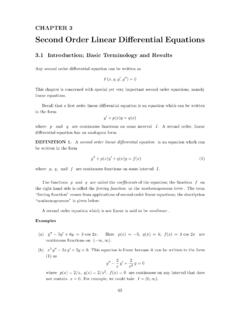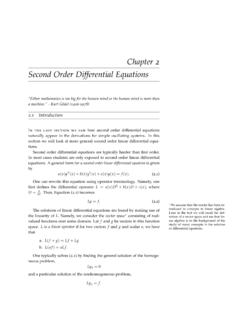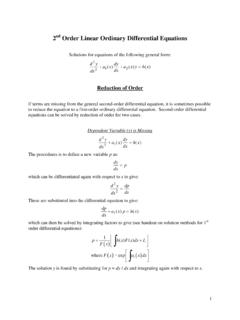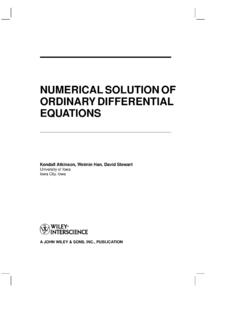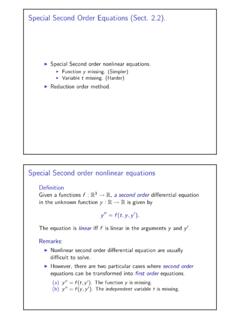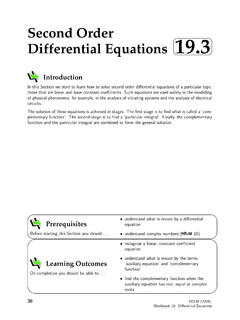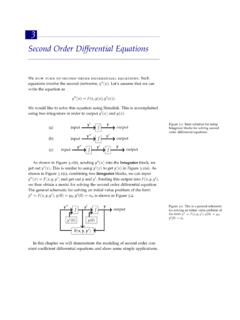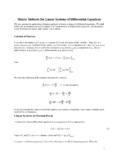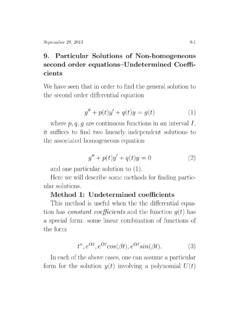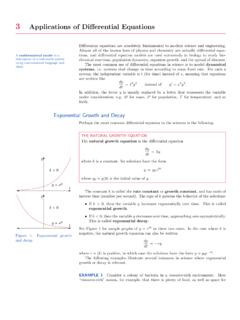Transcription of Chapter 3 Second Order Linear Differential Equations
1 Chapter 3 Second Order Linear Introduction; Basic TerminologyRecall that a first Order Linear differential equation is an equation which can be writtenin the formy +p(x)y=q(x)wherepandqare continuous functions on some intervalI. A Second Order lineardifferential equation has an analogous Order Linear differential EQUATION:Asecond or-der, Linear differential equationis an equation which can be written in the formy +p(x)y +q(x)y=f(x)(1)wherep, q, andfare continuous functions on some functionspandqare called thecoefficientsof the equation; the functionfon the right-hand side is called theforcing functionor thenonhomogeneous term. The term forcing function comes from the applications of Second - Order Equations ;an explanation of the alternative term nonhomogeneous is given Second Order equation which is not Linear is said to on Linear . SetL[y]=y +p(x)y +q(x)y. If we viewLasan operator that transforms a twice differentiable functiony=y(x) into thecontinuous functionL[y(x)] =y (x)+p(x)y (x)+q(x)y(x),39then, for any two twice differentiable functionsy1(x) andy2(x),L[y1(x)+y2(x)] =L[y1(x)] +L[y2(x)]and, for any constantc,L[cy(x)] =cL[y(x)].
2 As introduced in Section ,Lis a Linear transformation, specifically, alineardifferential operator:L:C2(I) C(I)whereC2(I) is the vector space of twice continuously differentiable functions onIandC(I) is the vector space of continuous functions onI. The first thing we need to know is that an initial-value problem has a solution,and that it is 1. (Existence and Uniqueness Theorem:)Given the secondorder Linear equation (1). Letabe any point on the intervalI, and let and be any two real numbers. Then the initial-value problemy +p(x)y +q(x)y=f(x),y(a)= , y (a)= has a unique proof of this theorem is beyond the scope of this :We can solve any first Order Linear differential equation; Chapter 2 gives amethod for finding the general solution ofanyfirst Order Linear equation. In contrast,there is no general method for solving Second (or higher) Order Linear differentialequations. There are, however, methods for solving certain special types of secondorder Linear Equations and we ll consider these in this Chapter .
3 DEFINITION 1.(Homogeneous/Nonhomogeneous Equations ) The lineardifferential equation (1) ishomogeneous1if the functionfon the right side is 0for allx I. In this case, equation (1) becomesy +p(x)y +q(x)y=0.(2)Equation (1) isnonhomogeneousiffis not the zero function onI, , (1) isnonhomogeneous iff(x)6= 0 for somex use of the term homogeneous is completely different from its use to categorize the firstorder equationy =f(x,y) in Exercises reasons which will become clear, almost all of our attention is focused onhomogeneous EquationsAs defined above, a Second Order , Linear , homogeneous differential equation is anequation that can be written in the formy +p(x)y +q(x)y= 0(3)wherepandqare continuous functions on some Trivial Solution:The first thing to note is that the zero function,y(x)=0for allx I, (also denoted byy 0) is a solution of (1). The zero solution is calledthetrivial solution. Obviously our main interest is in findingnontrivialsolutions. LetS={y=y(x):yis a solution of (1)};Sis a subset ofC2(I).
4 THEOREM (x),y=v(x) S, and letCbe any real (x)=u(x)+v(x) Sandy(x)=Cu(x) is,Sis a subspace ofC2(I). Indeed,Sis thenull spaceof the lineardifferential operatorL. Theorem 1 can be restated as: Ify=y1(x),y=y2(x) SandC1,C2arereal numbers, thenC1y1+C2y2 expressionC1y1+C2y2is called alinear that the equationy(x)=C1y1(x)+C2y2(x)(4)whereC1an dC2are arbitrary constants, has the form of the general solution ofequation (1). So the question is: Ify1andy2are solutions of (1), is the expression(2) the general solution of (1)? That is, can every solution of (1) be written as alinear combination ofy1andy2? It turns out that (2) may or not be the generalsolution; it depends on the relation between the thaty=y1(x) andy=y2(x) are solutions of equation (1). Underwhat conditions is (2) the general solution of (1)?Letu=u(x)beanysolution of (1) and chooseanypointa I. Suppose that =u(a), =u (a).Thenuis a member of the two-parameter family (2) if and only if there are valuesforC1andC2such thatC1y1(a)+C2y2(a)= C1y 1(a)+C2y 2(a)= If we multiply the first equation byy 2(a), the Second equation by y2(a), and add,we get[y1(a)y 2(a) y2(a)y 1(a)]C1= y 2(a) y2(a).
5 Similarly, if we multiply the first equation by y 1(a), the Second equation byy1(a),and add, we get[y1(a)y 2(a) y2(a)y 1(a)]C2= y 1(a)+ y1(a).We are guaranteed that this pair of Equations has solutionsC1,C2if and only ify1(a)y 2(a) y2(a)y 1(a)6=0in which caseC1= y 2(a) y2(a)y1(a)y 2(a) y2(a)y 1(a)andC2= y 1(a)+ y1(a)y1(a)y 2(a) y2(a)y 1(a).Sinceawas chosen to be any point onI, we conclude that (2) is the generalsolution of (1) if and only ify1(x)y 2(x) y2(x)y 1(x)6= 0 for allx 2. (Wronskian)Lety=y1(x) andy=y2(x) be solutions of(1). The functionWdefined byW[y1,y2](x)=y1(x)y 2(x) y2(x)y 1(x)is called theWronskianofy1, use the notationW[y1,y2](x) to emphasize that the Wronskian is a functionofxthat is determined by two solutionsy1,y2of equation (1). When there is nodanger of confusion, we ll shorten the notation toW(x).RemarkNote thatW(x)= y1(x)y2(x)y 1(x)y 2(x) =y1(x)y 2(x) y2(x)y 1(x). THEOREM (x) andy=y2(x) be solutions of equation (1), and letW(x) be their Wronskian.
6 Exactly one of the following holds:(i)W(x) = 0 for allx Iandy1is a constant multiple ofy2.(ii)W(x)6= 0 for allx Iandy=C1y1(x)+C2y2(x) is the general solution of(1)DEFINITION 3. (Fundamental Set)A pair of solutionsy=y1(x),y=y2(x)of equation (1) forms afundamental set of solutionsifW[y1,y2](x)6= 0 for allx Dependence; Linear IndependenceBy Theorem 3, ify1andy2are solutions of equation (1) such thatW[y1,y2] 0,theny1is a constant multiple ofy2. The question as to whether or not one functionis a multiple of another function and the consequences of this are of fundamentalimportance in differential Equations and in Linear this sub-section we are dealing with functions in general, not just solutions ofthe differential equation (1)DEFINITION 4. ( Linear Dependence; Linear Independence)Given twofunctionsf=f(x),g=g(x) defined on an intervalI. The functionsfandgarelinearly dependent onIif and only if there exist two real numbersc1andc2,not both zero, such thatc1f(x)+c2g(x) functionsfandgarelinearly independent onIif they are not linearlydependent.
7 Linear dependence can be stated equivalently as:fandgare linearly dependentonIif and only if one of the functions is a constant multiple of the term Wronskian defined above for two solutions of equation (1) can be ex-tended to any two differentiable functionsfandg. Letf=f(x) andg=g(x)be differentiable functions on an intervalI. The functionW[f,g] defined byW[f,g](x)=f(x)g (x) g(x)f (x)is called theWronskianoff, is a connection between Linear dependence/independence and (x) andg=g(x) be differentiable functions on linearly dependent onI, thenW(x) = 0 for allx I(W 0onI). This theorem can be stated equivalently as: Letf=f(x) andg=g(x)bedifferentiable functions on an (x)6= 0 for at least onex I, thenfandgare linearly independent back to differential Equations , Theorem 4 can be restated asTheorem 4 Lety=y1(x) andy=y2(x) be solutions of equation (1). Exactlyone of the following holds:(i)W(x) = 0 for allx I;y1andy2are Linear dependent.(ii)W(x)6= 0 for allx I;y1andy2are linearly independent andy=C1y1(x)+C2y2(x) is the general solution of (1).
8 The statements y1(x),y2(x) form a fundamental set of solutions of (1) and y1(x),y2(x) are linearly independent solutions of (1) are results of this section can be captured in one statementThe setSof solutions of (1), a subspace ofC2(I), has dimension 2, the Order of the Exercises 1 2, verify that the functionsy1andy2are solutions of the givendifferential equation. Do they constitute a fundamental set of solutions of the equa-tion? 4y +4y=0;y1(x)=e2x,y2(x)= x(x+2)y +(x+2)y=0;y1(x)=x, y2(x)= Given the differential equationy 3y 4y=0.(a) Find two values ofrsuch thaty=erxis a solution of the equation.(b) Determine a fundamental set of solutions and give the general solution ofthe equation.(c) Find the solution of the equation satisfying the initial conditionsy(0) =1,y (0) = Given the differential equationy (2x)y (4x2)y=0.(a) Find two values ofrsuch thaty=xris a solution of the equation.(b) Determine a fundamental set of solutions and give the general solution ofthe equation.
9 (c) Find the solution of the equation satisfying the initial conditionsy(1) =2,y (1) = 1.(d) Find the solution of the equation satisfying the initial conditionsy(2) =y (2) = Given the differential equation (x2+2x 1)y 2(x+1)y +2y=0.(a) Show that the equation has a Linear polynomial and a quadratic polyno-mial as Find two linearly independent solutions of the equation and give the gen-eral Lety=y1(x) be a solution of (1):y +p(x)y +q(x)y= 0 wherepandqarecontinuous function on an intervalI. Leta Iand assume thaty1(x)6=0onI. Sety2(x)=y1(x) xae tap(u)duy21(t) thaty2is a solution of (1) and thaty1andy2are linearly Exercise 6 to find a fundamental set of solutions of the given equationstarting from the given 2xy +2x2y=0;y1(x)= 2x 1xy +x 1xy=0;y1(x)= Lety=y1(x) andy=y2(x) be solutions of equation (1):y +p(x)y +q(x)y=0on an intervalI. Leta Iand suppose thaty1(a)= , y 1(a)= andy2(a)= , y 2(a)= .Under what conditions on , , , will the functionsy1andy2be linearlyindependent onI?
10 10. Suppose thaty=y1(x) andy=y2(x) are solutions of (1). Show that ify1(x)6=0 onIandW[y1,y2](x) 0onI, theny2(x)= y1(x) Homogenous Equations with Constant CoefficientsWe have emphasized that there are no general methods for solving Second (or higher) Order Linear differential Equations . However, there are some special cases for whichsolution methods do exist. In this and the following sections we consider such a case, Linear Equations with constant Order , Linear , homogeneous differential equation with constant coefficientsis an equation which can be written in the formy +ay +by= 0(1)whereaandbare real have seen that the functiony=e axis a solution of the first- Order linearequationy +ay=0,the equation modeling exponential growth and decay. This suggests that equation(1) may also have an exponential functiony=erxas a , theny =rerxandy =r2erx. Substitution into (1) givesr2erx+a(rerx)+b(erx)=erx(r2+ar+b)= 0 for allx, we conclude thaty=erxis a solution of (1) if and only ifr2+ar+b=0.
